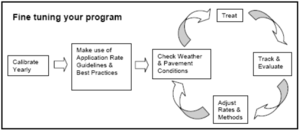
MS4 fact sheet - Winter Road Materials Management
Contents
Winter Road Materials Management
Management of winter road materials and associated pollutants
The concentration of chloride is increasing in our surface and ground water largely due to stormwater runoff from road salt storage piles, areas of excessive application, or simply from years of repeated application since chloride does not degrade in soil and water. Chloride in road salt and road salt additives (e.g. ferrocyanide for anti-caking) can create toxic conditions for fish, insects and vegetation.
Sodium from road salt can compromise soil structure thereby reducing its water retention capacity and increasing the potential for erosion. It can also reach levels in ground water that pose drinking water problems. Associated materials that could also pose water quality problems could include sand (anti-skid agent) and phosphorus related to both the salt and the sand. This fact sheet provides guidance on the management of winter road materials.
Benefits / Pollution Reduction
Minnesota Statute 160.215 states that the application of salt and chemicals for snow removal and road de-icing shall be restricted to reduce the pollution of waters. Proper road salt storage, handling, and application reduce the risk of downstream water resources pollution and can reduce die-off of exposed vegetation, fish, and other aquatic organisms. Best management practices (BMPs) can also protect ground water supplies from contamination Ground water is the source of approximately 70% of the drinking water in Minnesota. Efficient storage, handling, and application rates can also reduce materials costs. Details on the nature of the salt problem and possible approaches to controlling it are contained in the Minnesota Stormwater Manual (Chapter 9).
Program Development & Implementation
Salt Management Plans
A municipal salt management plan is a commitment to implementing BMPs while fulfilling a community’s obligation to provide safe, efficient and cost-effective roads. The plan should identify BMPs to reduce the negative environmental impacts of road salt. The plan should apply to all winter maintenance personnel including staff and contractors. The Canadian Public Works Association (CPWA) and Transportation Association of Canada (TAC) provide helpful guidance on salt management plans. The CPWA and TAC recommend the following framework for a salt management plan:
Salt management policy and objectives Adopt a salt management policy that commits to measurable improvements in salt management practices.
Review of current practices Inventory current practices to form a benchmark against which progress can be measured and tracked. Consider current application rates for each material, percentage of fleet with electronic spreader controls, BMPs implemented in salt-vulnerable areas, percentage of sand/salt piles covered, percentage of snow disposal sites with water management systems, and percentage and frequency of staff receiving training.
Documentation of policies, procedures and guidelines Level of service for each roadway type, salt/sand application rates, managed salt/sand storage, good housekeeping practices, equipment calibration and re-calibration, training, snow disposal, incorporation of salt management consideration into road design and construction, and salt vulnerable areas.
Proposed approaches, including BMPs and assigned responsibilities Identify clear tasks, schedules with milestones, budget considerations and assigned responsibilities for implementing BMPs. Address the following four areas of concern: general road use, salt use in salt vulnerable areas, salt storage and mixing, and snow storage and disposal.
Training Include a comprehensive education and training program that demonstrates the value of new procedures and ensures that managers, supervisors, and operators are
